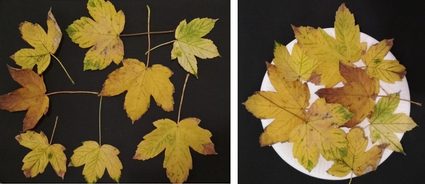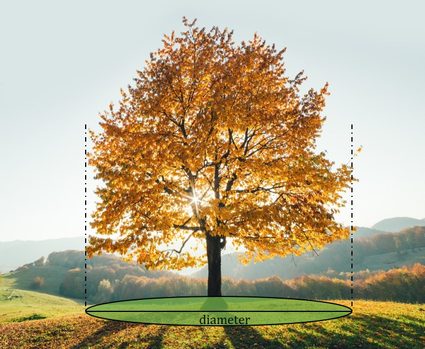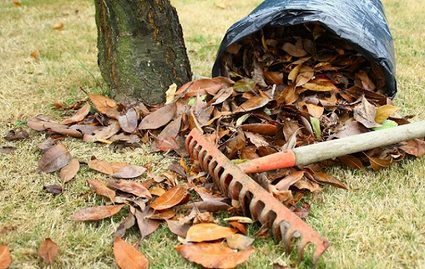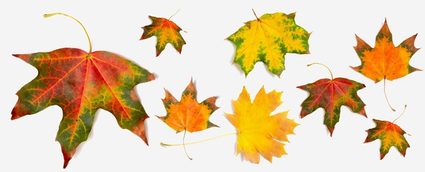Tree Leaves Calculator
The tree leaves calculator tells you how many leaves are on your tree. Although this is a rough approximation, you can still get an idea about the order of magnitude of the number of leaves. Have you ever thought about it? Are there 10 thousand, 100 thousand, or maybe 1 million leaves on the big oak? In the following text, we have explained how you can estimate the number of leaves on a tree in a few simple steps.
Autumn is one of the four temperate seasons, starting in September in the Northern Hemisphere and March in the Southern Hemisphere. This is a time when the world changes its color. Green forests and trees in park alleys become yellow, orange, brown, red, and even purple. Thousands of autumn leaves start falling and cover the ground. We want to keep our yards clean and neat, so we bring out rakes and form large piles of leaves. How many leaves are in such a pile? How many bags do you need to pick up all the leaves? With our tree leaves calculator, you can find the answers to these problems!
Have you ever wondered why there are such visible changes in nature at the end of the year? In fact, the autumn phenomenon isn't as complicated from a scientific point of view as you would think. Leaves are the primary source of energy for trees during most of the year. However, to survive the winter, trees must get rid of the leaves in autumn. Energy is produced from sunlight by an organic chemical compound present in the leaf – chlorophyll. Also, chlorophyll is responsible for the green color of almost every plant. Without this substance, leaves would have their "true" color, e.g., orange, red, or yellow. Read the following article to learn more about the scientific description of autumn.
How many leaves are on a tree?
If you want to count how many leaves are on a tree, you can try to do it one by one. However, we warn you that it can be as tricky as counting stars in the night sky – or even more complex. And it will be for sure time-consuming. Instead, you can use our tree leaves calculator and make a rough estimation of the number of leaves in just 5 simple steps:
-
Prepare a round paper plate and cover it with a layer of leaves from the chosen tree. Try to create a single layer without any gap and leaves overlapping. Then determine the exact number of required leaves. It could be a little bit challenging with dried, wavy, and fragile leaves and will resemble solving a jigsaw puzzle. To improve the accuracy of the estimation, use both small and large leaves. Measure the diameter of the paper plate and enter its value into the appropriate field in this calculator. This way, you have estimated how many individual leaves it would take to cover a single layer of a specific area. In other words, you have determined the area density of leaves formula with an area given by the area of a circle.
area density = no. leaves on plate / area of plate

-
Measure the average diameter of the projection of the tree's crown on the ground. To do this, locate the outer edge of leaves on one side of the tree and stand beneath it. Then find a similar location on the opposite side of the tree and measure the distance between these two points. This is the diameter of the projection of the tree's crown on the ground that you should enter into our tree leaves calculator.
We are well aware that tree crowns aren't perfectly symmetrical. Some trees are dome-shaped, some are tall and narrow, and some have branches pointing only in a few specific directions. However, you should always be able to find a distance that seems typical. If you want, you can refine this approximation by making a few measurements with different endpoints and taking an average value – you can use the average calculator to write down the results and analyze them immediately. With this diameter, you have determined the area beneath the tree's crown (the area of a circle) and, therefore, the number of leaves required to cover it entirely with a single layer. This is provided by the formula:
no. leaves beneath crown = area density × area beneath crown

-
Choose the species of a tree you have examined. So far, we have estimated the number of leaves that covers only one layer. To get qualitative knowledge of how many leaves actually overlap each other in the tree's crown, we can use a quantity called the Leaf Area Index (LAI). It is the total area of all leaves relative to the ground surface within a given area. This parameter has been the subject of many ecological research projects (a huge global database with different plants around the world can be found on the ).
The typical value of LAI of deciduous trees is about 4-8 (we have taken the average LAI = 4.7 from the database). In this leaves calculator, you can switch between the ten most common deciduous trees in the USA, or you can manually enter the LAI, by selecting "enter custom LAI value" in the tree species selection. To sum up, the total number of leaves that grows on the tree is expressed by the following equation:
total no. leaves = LAI × no. leaves beneath crown
For example, we have a paper plate with a diameter of 10 in. We used 8 maple leaves to cover the plate, but there were some gaps. So let's say we need 9 leaves to cover it entirely. The measured diameter of the tree crown projection on the ground is about 30 ft. Since we have collected leaves from the sycamore maple, let's choose the LAI of a typical deciduous tree. That's all! The number of leaves on our tree is about 50 thousand. Is it a small or a big value? What do you think?
If you wish to plant trees, we have a tree spacing calculator that will help you to determine the correct distance to plant whatever type of tree you are longing after.
How many bags are needed to gather autumn leaves?
Autumn is the time of falling leaves and their endless raking. Some of us may think that autumn leaves are colorful and they look pretty on the grass. Why is it necessary to rake them off the lawn? During autumn, the sunlight, nutrients, water, and temperatures are perfect for growing grass. However, a thick layer of leaves can make it impossible for grass to "breathe", harming the lawn's health. Lasting leaves can even prevent the grass from emerging next spring!
You should take care of your lawn, rake the leaves and pack them into bags. At some point, you may wonder how many bags you need to gather leaves from all the trees in your yard. How heavy will they be? Our leaves calculator can manage this problem too! You need to do the following steps:
-
Find the total number of leaves of a single tree in your yard. Enter the appropriate value into the field "Number of leaves on a tree" or use our calculator to estimate it. If you have many trees of different species and sizes, try to choose the tree that could be considered an "average tree".
no. leaves = no. trees × no. leaves on single tree -
Specify the number of trees in your yard.
-
Take a sample of the leaves, squash it and measure the diameter of the ball you have created. We want to simulate the leaves that will be in the bag. Take a bunch of leaves and count them. Then try to form a ball that fits in your hands, release it and measure the diameter of the resulting shape. Enter the number of the leaves in the ball and their diameter into the appropriate fields of the leaves calculator. In that way, you have found a density of leaves in the bag which is the number of leaves per volume unit (don't be confused with the mass density), where the volume is a volume of a sphere:
density = no. leaves in ball / volume of ball
-
Enter the volume of the bags you will use to collect the leaves. With this information, you can already find out how many bags of a specific volume you need to hold all the leaves from your yard. The total volume occupied by leaves equals the number of leaves divided by density, so the mathematical formula is as below:
no. bags = (no. leaves / density) / volume of bag -
Enter the mass of one leaf (optional). If you also want to find the weight of one bag, you need to enter the mass of one leaf. Determining this mass may be difficult with only one leaf if you're using an ordinary scale. However, you can take a whole bunch of leaves (just as before), weigh them, and count the leaves inside. Then divide the measured mass by the number of leaves, and you will obtain the average mass of one leaf. The weight of one bag is a product of the number of leaves in one bag (volume of bag times density) and the mass of one leaf:
weight of bag = (volume of bag × density) × mass of leaf
Remember that you don't have to collect all the leaves in your yard. You can save effort and neglect some fallen leaves under trees and shrubs. After winter, they will turn into compost providing nutrients to your plants in the spring.
It is easier to bag the leaves if you rake them into a few piles first. If you have already created some piles, you can try the "How many leaves are in a pile?" section of our leaves calculator and estimate the total number of leaves in one pile. The procedure is similar to the steps described above. Take a sample of leaves from a pile, form a ball (don't squash it this time!), and measure its diameter. Then determine the diameter and height of the whole pile of leaves. In our calculations, we assumed that a pile could be modeled with the cone.

Leaves – a source of energy
Like most plant species, deciduous trees are self-sustaining organisms that produce food by themselves through photosynthesis. It is a process that takes place in the green parts of plants, especially in the leaves. Due to photosynthesis, plants can use the energy from sunlight to produce glucose from the carbon dioxide CO₂ and water H₂O. The absence of any of these ingredients prevents photosynthesis.
The vital part of leaves is a chemical compound called chlorophyll. Sunlight is white light. In other words, we can say that it consists of three parts: red light, blue light, and green light. On the one hand, chlorophyll molecules allow plants to absorb energy from the sun, mostly blue and red lights. On the other hand, most of the green light is reflected, which is why almost all the leaves are green in the spring or summer.

We already know that trees are indeed priceless. However, for some purposes, it is also possible to estimate their value, e.g., with our tree value calculator. 🌳
True colors of leaves
The high content of chlorophyll in plants is responsible for their green color. In fact, chlorophyll isn't the only chemical compound in leaves that influences color. Leaves also consist of such pigments as carotenoids, anthocyanins, and xanthophylls, giving rise to orange, red, and yellow colors. However, most of the year, we cannot see them under the dominant green chlorophyll.
In autumn, a tree begins to dispose of the green pigment into nutrients (which have been stored in the leaves so far) and transfers them to the tree's roots to store until the next spring. When leaves get rid of chlorophyll, the remaining colors start to appear in our eyes which allows other parts of visible light to be used in photosynthesis. Thanks to this, plants can still produce some energy at the end of vegetation. And once the leaf is completely brown, it means all the pigments have been removed from it – the leaves wither.
Leaves are a tiny miracle of hydraulic and biological engineering. If you want to find out more about how they help in the "operations" of a tree, check out our water potential calculator.

Could leaves stay on trees in the winter?
In winter, there is enough carbon dioxide but sunlight or water for photosynthesis. Since there will be no photosynthesis, the trees won't need leaves. But do trees really need to shed them in autumn? Couldn't the leaves stay on trees and just do nothing until spring? The answer is no!
Trees in a temperate climate cannot afford to keep their green leaves. It is quite expensive for plants to hold them because leaves are mainly made up of water (and water freezes in winter). They need water not only to produce energy but also to stay alive and build their tissues. Keeping leaves in winter would be very unprofitable for trees. They wouldn't contribute anything on their own, and also, they would use and lose precious water by themselves. That's why the trees have to drop their leaves.
In winter, trees have to save water and accumulated nutrients. Once the leaves have been dropped, the tree is at rest. Without "expensive" leaves, they have much less water and food requirements. They accumulate reserves for the winter, like sugars and fats, in trunks, branches, and roots. Thanks to them they will survive low temperatures and lack of light.
Another question related to trees is how to tell how old a tree is. The tree age calculator is a tool designed specifically for that purpose. Be sure to check it in your free time!